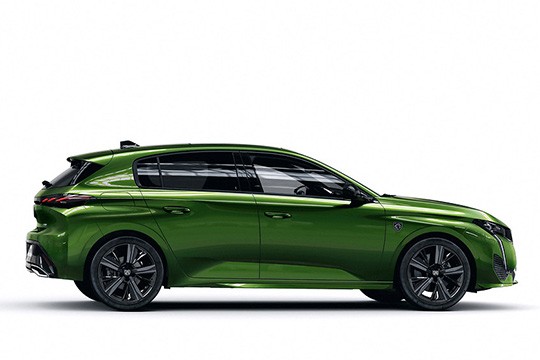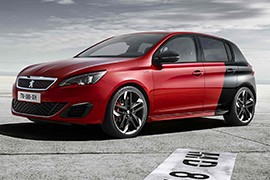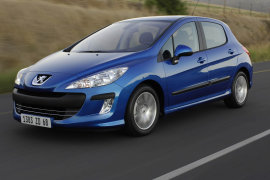PEUGEOT 308 5 Doors Models/Series Timeline, Specifications & Photos
First production year: 2008
Engines: Gasoline, Diesel, Hybrid gasoline, Ethanol
Body style: Hatchback
Peugeot introduced the third generation of the 308 hatchback in 2021 with a design that carried over elements from its bigger brothers from the crossover segment.
The French carmaker was eager to defeat the Golf at its game and tried to attack the segment differently. It was the first Peugeot to sports the refreshed company logo, which showed a lion head instead of the entire feline.
With cues inspired from its award-winning bigger brother 3008, the 308 displayed a front fascia with the vertical LED "fangs" on the outer side. It's big mesh-grille looked more aggressive than any of its predecessors, while the LED headlights peeked under the hood line. From its sides, its cab-rearward design inspired a rear-wheel-drive vehicle due to its thick C-pillar and curved roofline. Its sculptured side panels and doors formed a complex aerodynamic flow, reducing the drag-resistance factor. At the back, its taillights formed a long smoked line across the tailgate. Despite the downsize and electrification trends on the market, Peugeot installed fake, chromed exhausts under the apron.
The interior looked like its designers didn't communicate with those who shaped the car's exterior. While on the outside, the 308 featured long, curved lines, the minimalist dashboard exposed straight lines, hard edges, and F-117 Stealth style surfaces. The steering wheel was unusually low mounted compared to the instrument cluster. Like its bigger brother 3008, the 308 featured a TFT display for the instrument panel and a secondary touch-screen for the infotainment screen. In the back, Peugeot installed a split-folding bench where three passengers could sit comfortably.
Under the hood, the carmaker installed a choice of gasoline, turbo-diesel, and hybrid systems that could offer up to 225 hp sent to the front wheels via a six-speed manual or an eight-speed automatic.
The second generation of the compact-sized Peugeot 308 was introduced in 2013 and, four years later, a facelift improved the vehicle with new features and a bolder design.
The 2017 Peugeot 308 was an improved version of the second generation of the 308. It was difficult to enhance the model since the 308 was the 2014 “Car of the year” in Europe. But still, there were some ways to improve it.
From the outside, the most noticeable change was on the headlights, which received the LED daytime running lights that looked like claws, inspired by the brand's logo, the lion. At the front, a wide grille was installed. Its design was continued on the front bumper. On the sides, the bumper featured two large air scoops. The profile remained the same, but with some touches on the bodywork.
Inside, the 308 featured a better infotainment system with a touch-screen on top of the center console, integrated into the dashboard. The navigation system was developed together with TomTom and it featured live traffic information. The infotainment unit featured a screen-mirroring function for both Android Auto and Apple CarPlay. The 5-door version offered enough room for five adult passengers. The EMP2 platform allowed more rear legroom for the passengers.
Under the hood, the 308 5-doors. Was offered with diesel and gasoline engines. A newly developed 8-speed automatic gearbox was available for specific engines.
Peugeot has a long history in the hot-hatch segment, starting with the famous 205 GTI that it launched in 1984 and continuing with other successful models, and the 2017 308 GTi was no exception.
When the French automaker introduced the 205 GTi on the market in 1984, it was a massive success. Not only could the car compete with the better-known Volkswagen Golf GTI, but it also ripped a big chunk of the hot-hatch segment, which was not exactly wide then. Furthermore, the French automaker's involvement in the World Rally Championship and winning several World Titles made it famous. The low acquisition price compared to other similar vehicles coming from Italy, UK, or Germany helped Peugeot increase its brand awareness. But fast forward to 2017, and the second generation of the 308 compact hatchback has received a GTi treatment.
The second generation of the 308 was already a sporty-looking vehicle, but with the GTi-specific trims, it looked ferocious for its class. It sported standard LED headlights, like eyebrows, with pearls-like LED daytime running lights above. They flanked a black grille where the chromed badge of the carmaker took center stage. Lower, on the bumper, the 308 GTI got an apron that featured a second wide air intake in the middle flanked by rectangular side scoops with vents.
From its sides, the car showed its lower stance, with a ground clearance reduced by 1 centimeter (0.5-inch) compared to the rest of the 308 range. Its red GTi badges on the front fenders and the 19" alloy wheels were unique for this version of the French hot hatch. Unlike its famous 205 GTi predecessor, the 2017 308 GTi was available exclusively as a five-door affair, but it was offered with a two-ton bodywork, sporting a black color for the rear side of the vehicle. Finally, at the back, the roof spoiler had an integrated third brake lamp, and the lower bumper featured a diffuser flanked by two chromed exhausts.
Inside, the car's sporty character was emphasized by high-bolstered sports seats at the front with integrated headrests. The driver fronted a binocular-style instrument cluster like in the regular 308 but fitted with red-illuminated numbers on the dials. The automaker added a tiny TFT display that showed additional information from the car's onboard computer between the speedometer and tachometer. A flat-bottom steering wheel adorned with the GTi badge on its lower spoke and the aluminum pedals completed the image of a true hot-hatch. In the back, the 60/40 split-folding bench seat sported the same materials as on the front seats.
Under the 308 GTi’s hood, Peugeot opted for a 1.6-liter turbocharged gasoline engine available in two output versions of 263 PS (259 hp) and 272 PS (268 hp), respectively. Both versions were paired with a six-speed manual that sent the power to the front wheels via a Torsen limited-slip differential.
While it wasn't the most powerful version of the 308, the GT offered a very good balance between performance and daily use of a sport-compact hatchback.
Peugeot had a great motorsport reputation, and one of the greatest rally cars ever made was the iconic 205. It wasn't easy to replace it, but in the end, the carmaker had to move on and introduced new vehicles on the market. It is argued whether the 208 or the 308 was the true successor of that iconic car. In the '80s, the 205 was considered a compact vehicle. By the 2017 standards, the 308 was in that segment, but the 208 was closer to the original, 205, size.
The French carmaker introduced a facelift for the 308 second generation in 2017, four years after the model's launch. It sported re-worked bumpers both front and rear, new headlights, and taillights. In the GT version, the car featured 18" light-alloy wheels fitted as standard and a squared filler cap.
Inside, the sport-inspired interior shook with its sport-bucket seats, which looked like they were carried-over from a supercar. Their high-bolstering backseats offered both comfort and side support. Peugeot installed an infotainment screen on top of the center stack, embedded in the dashboard.
Under the hood, Peugeot installed a 1.6-liter gasoline engine that provided 205 hp. The most potent version of the 308 was the Gti, which offered 250 hp from the same four-pot unit.
Peugeot was known for its GTi models that followed after the successful 205 model, which was the initial wearer of this badge, and later it transferred it to several other hatchbacks, such as the 308, which broke covers in 2015.
The French automaker introduced the second generation of the 308 in 2013, but it didn’t rush to unveil the sportiest version of it, the GTi. But in 2015, this version made it to the market, and customers received it with a mixed feeling. On the upside, it was a fresh hatchback that could run fast and wasn’t very expensive. On the downside, it was only available with five doors, which was somewhat in contradiction with the original idea behind this three-letter badge. Still, after the initial shock, people understood it: it was the sporty compact hatchback good for young families, so everyone onboard could enjoy it.
Right from the start, customers could recognize the sportiest version of the 308 family thanks to the revised front fascia. There, Peugeot installed a sportier grille above the bumper surrounded by a chromed trim, while on the lower side, in the apron, it placed a broad grille adorned by a red trim on the lower side, flanked by a pair of fake scoops. Another essential update for this version was the LED headlights, which improved visibility and increased safety. From its profile, the GTi featured a lower ground clearance than its regular sibling. To hide the rear doors, the automaker offered customers the option to get the car in a two-tone paint that made the five-door hatchback look like it had just three doors. Finally, at the back, the carmaker installed side exhausts at the lower part of the bumper that flanked a fake diffuser.
Inside, the sporty treatment continued with a three-spoke flat-bottom steering wheel adorned by a GTi badge on the lower spoke. Moreover, Peugeot added aluminum pedals for it and several light-gray trims around the cabin. Just like its siblings, it featured a two-dial instrument cluster with an LCD between the rev counter and the speedometer. In addition, the center stack housed the screen for the infotainment system. The high-bolstered front seats promise customers that they’ll stay in place during high-speed cornering maneuvers, and they’ll also offer enough comfort. In the back, the carmaker placed the same split-folding bench seat as in the regular 308, albeit upholstered in more expensive materials.
But the most important part of a GTi was under its skin. Peugeot installed the same 1.6-liter turbocharged engine under the hood and made it available in two power versions: a 250 PS unit and a 270 PS one (247 HP and 266 HP, respectively). All versions were paired with a sleek six-speed manual that sent the power to the front wheels only. The more powerful version was also offered with an electronically controlled limited-slip differential.
The GTi history is long in the Peugeot family and goes back in time in the '80s. In 2014, the French manufacturer released a softer brother for the 308 GTI: the 308 GT.
Back in the '80s, it was a rare thing to see a fuel injection model on a compact car. But over the '90s, there were only a few vehicles that didn't have fuel injection. But the badge remained in glory. In 2014 all the performance hatchbacks had not only fuel injection, but they also had at least a turbocharger.
The 308 GT came with different styling and it was well equipped. It started on the front with a special design. It had the lion badge buried in the three-bar grille, the full-LED headlights, active turning signals in the bumper that scrolled the light outwards and some other chromed accents. The car featured 18" light-alloy wheels and, in the back, the dual chromed trapezoidal tailpipes came under a black diffuser. A small roof-spoiler complimented the rear sporty look.
Inside, the bolstered leather seats created a sporty look. The red stitches were everywhere inside the cabin. The instrument cluster featured a cockpit, meaning that there was a TFT configurable display. It also had an infotainment system that knew screen-mirroring with mobile phones.
The stiffened suspension, compared with other 308 models, had a pseudo-McPherson upfront and a deformable beam in the rear. Under the hood, the 308 GT was available with either a 2.0-liter turbodiesel unit or with 1.6-liter gasoline that features a twin-scroll turbocharger.
Taking a step in the right direction, Peugeot redesigned the 308 and turned it into a more practical and economical hatchback.
Featuring the new EMP2 modular platform, the new model had compact dimensions and its weight was reduced with 140 kg.
Aesthetically, the new design inspired style and strength with the more aggressive wheel arches and the new narrow grille. With the upper trim levels, the stylish hatchback was equipped with LED lights.
A major update, the size of the trunk was considerably increased. The rear seats could easily be folded, and while they didn’t fold flat, the trunk was big enough for big luggages.
The new Peugeot 308 was lower and wider than before, thus both ride quality and handling were improved.
The best fuel consumption was given by the 1.6-liter HDI engine that developed 115 hp. Other engine options were available, including gasoline engines for city roads.
Inside, the quality of the materials was improved, however, the cabin still featured hard plastics. The overall design was minimalistic and the upper trim levels added a touchscreen display.
The storage spaces inside the cabin were limited, especially with the tiny glovebox.
The compromise to offer such a big trunk was the short passenger space, with other competitors in the class offering better.
Peugeot introduced its new contender in the compact segment, and the five-door version was the most important from the sales point of view.
In 2008, the financial crisis shook the world, but the French carmaker didn't want to go with the same old 307. Moreover, it has already promised its customers and tried to keep it. Moreover, since the 308 was built on the same platform as its predecessor, the development and production costs were not that high.
There was a new design language on the 308, which was expressed by the V-shaped powerdome that adorned the hood. It was visually connected to the raked A-pillars, creating a unitary design. The feline-like headlights were typical for the French brand. On the front fascia, the grille was entirely moved on the lower side of the bumper, in the apron. From its profile, the 308 resembled the same shape as its predecessor but with more profound sculptured doors.
The carmaker installed bucket seats at the front and a split-folding rear bench inside the cabin. Thanks to the higher seating position, all occupants had enough legroom. Yet, the middle-rear passenger struggled with the center tunnel that crossed the car from front to back. The instrument panel resembled, somehow, the German competitor Volkswagen Golf. It sported middle-upper gauges flanked by the wider dials for the speedometer and tachometer. Moreover, the 308 showed a clear improvement in materials, fits, and finishes compared with the 307.
Under the hood, Peugeot installed an extensive engine choice, mostly with 1.6-liter displacement. However, it was the era of downsizing, and the carmaker had to adapt. It also offered a choice of turbo-diesel engines, which proved to be highly fuel-efficient.







